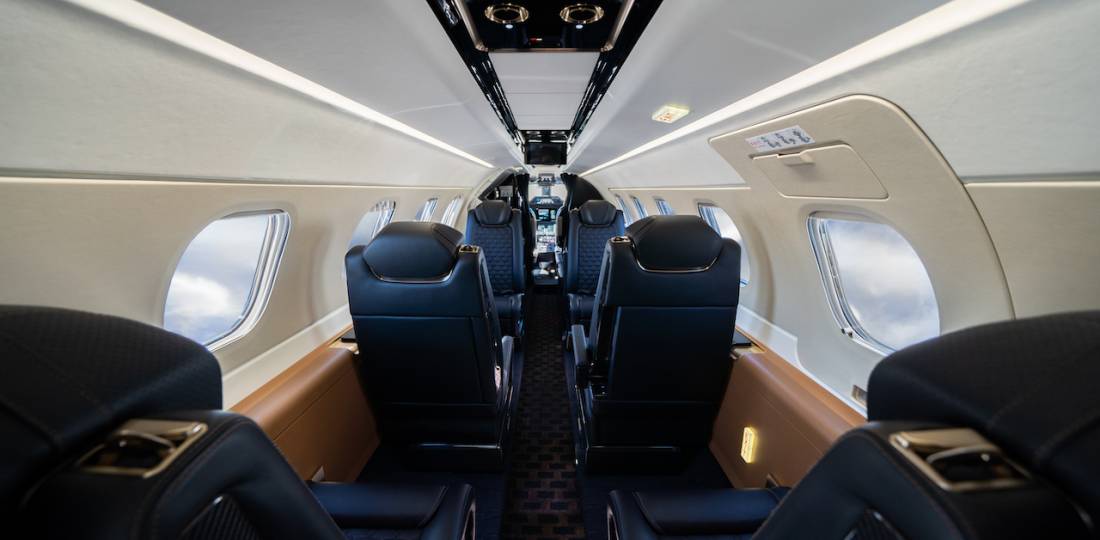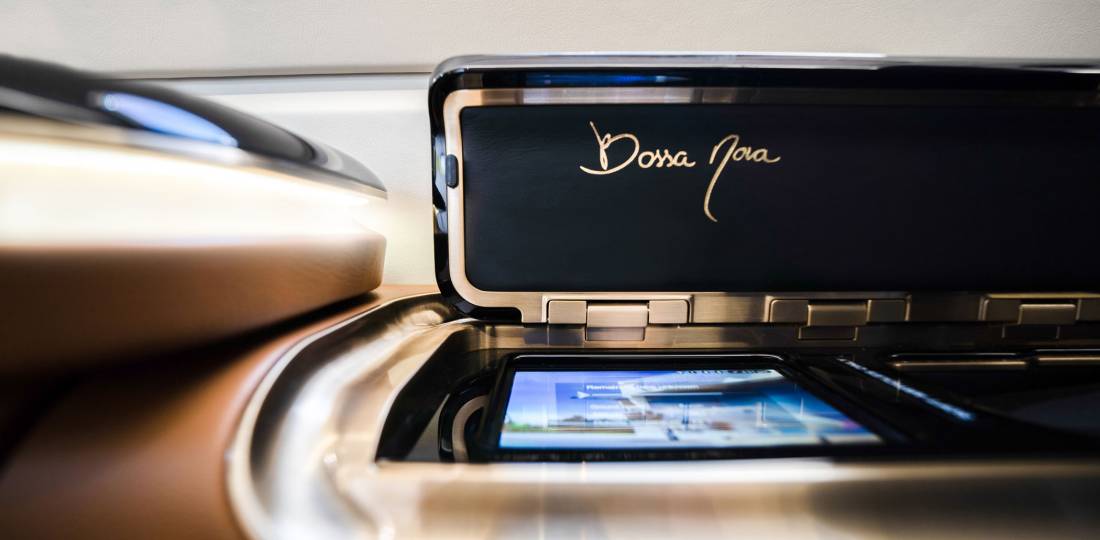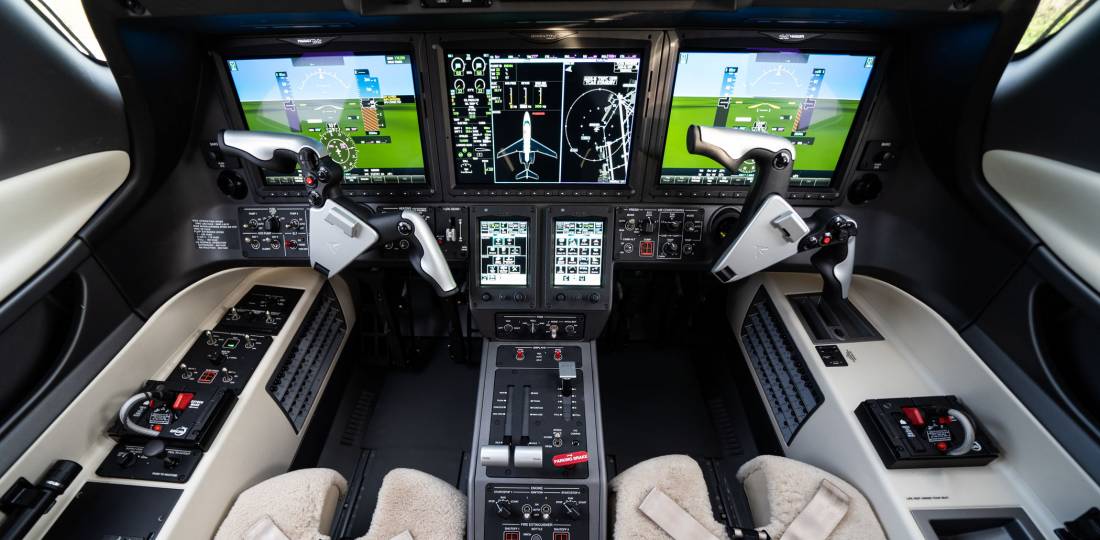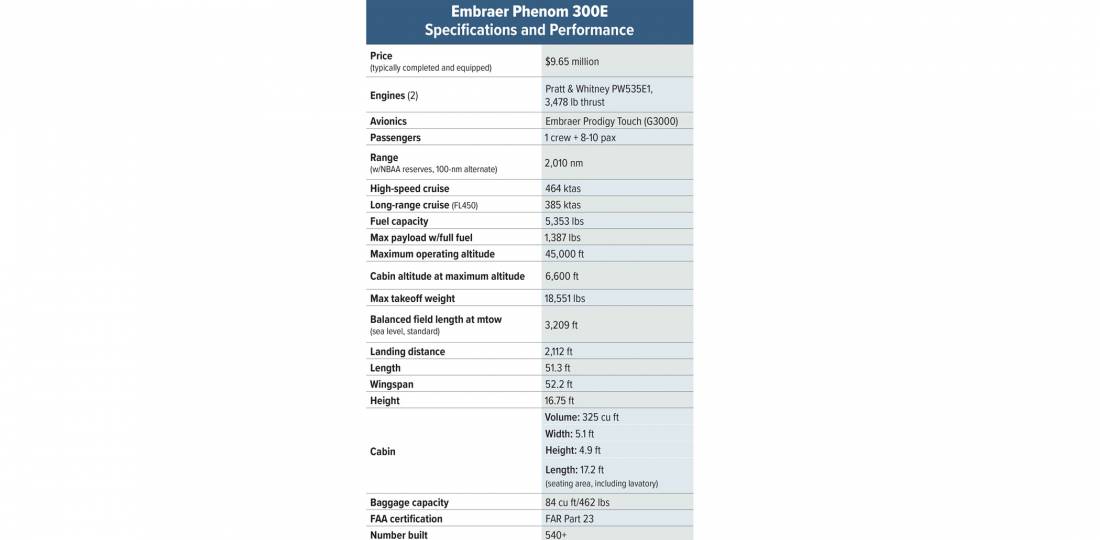Embraer’s new Phenom 300E received triple certification from Brazil’s ANAC, the FAA, and EASA in late March, about a month after I flew the high-performance jet at Embraer Executive Jets’ U.S. facility in Melbourne, Florida. It was an excellent opportunity to experience the 300E’s faster top speed, upgraded avionics, and improved cabin.
The Phenom 300 has been a best-selling light jet for the past seven years, with more than 540 entering service since the first delivery in 2009. Its competitors are Cessna’s Citation CJ3+ and CJ4, the Learjet 75, and Pilatus's PC-24.
In 2018, Embraer upgraded the Phenom 300 with the E package, adding new features to the cabin such as the upper tech panel for the Lufthansa Technik nice cabin management system and other comfort elements. What’s new in the updated $9.65 million 300E's cabin is the availability of the Bossa Nova interior, which takes features from the Praetor 600, such as Ipanema stitching and details, carbon-fiber accents, piano black veneer, accent leather, and gold-plating. The new interior is also now much quieter, thanks to engineering changes to mechanical components that improve noise characteristics. During the flight, I stepped back into the cabin and experienced the quiet atmosphere.
Sound-suppression improvements include new thermal-acoustic insulation, which lowers the high-pitch tone of the engines during climb by minimizing the blade-passing frequency perceived in the cabin, according to Embraer. Engineers also redesigned three check valves, with new valve geometry and materials that eliminate metallic flapper noise during descent and final approach. A new muffler in the vapor-cycle air-conditioning system eliminates noise from the condenser fan, which previously could be heard during approach; it also reduces noise from the system when it's running on the ground.
The 300E is available with three interior layouts. The maximum number of occupants in an available layout is 11 (one pilot, 10 passengers), and this includes a belted lavatory seat and a two-place divan opposite the main entry door. If that divan is replaced with a single seat, the total drops to 10. For nine occupants, the seat opposite the entry door is replaced with storage/galley features.

Another improvement for pilots and passengers is upgrading the airborne connectivity to Gogo’s Avance L5 air-to-ground system, which offers much faster service in the U.S. and many areas in Canada, allowing streaming of movies, emails with attachments, and Gogo’s Text & Talk service. Avance L5 does require two rather large antennas mounted on the bottom of the fuselage, but the faster service makes these worthwhile.
The most significant change in the new Phenom 300E is the more powerful Pratt & Whitney PW535E1 engines with 3,478 pounds of thrust, up by 118 pounds per engine. The increased power means faster time to climb and a new top speed of Mach .80 or 464 knots true airspeed, up from Mach .78 and 446 knots. The power increase was done via a software change to the engine’s full authority digital electronic engine controls, thanks to some extra power margin built into the engine. Time to climb to the maximum altitude of FL450, which can be done directly, is 24 minutes, one minute less than the previous 300E.

Embraer engineers were able to carve out extra fuel volume, and the 300E carries another 50 pounds, boosting maximum range to more than 2,100 nautical miles at long-range cruise speed.
Maximum payload remains the same at 2,436 pounds, but payload with maximum fuel is up 26 pounds to 1,387 pounds on the new model.
You can choose to go faster in the new 300E; or slow down and go farther. For example, with six occupants, range at long-range cruise speed is 2,010 nm. At maximum cruise speed, that drops to 1,865 nm. Those numbers are for the baseline airplane; most buyers will opt for typically equipped configurations, which means that you could still fly the 1,865 nm at high speed, but with five occupants, not six.
Taller pilots are going to love the new space on the flight deck. By moving the bulkheads behind the pilot seats farther aft and redesigning the location of some items that live in the bulkhead area, Embraer was able to add 40 percent to the length of the pilot seat tracks. This might not seem like much, but the flight deck can now comfortably accommodate pilots up to 6 feet 4 inches, solving an issue with the Phenom 300.

Avionics Upgrades
Pilots will also enjoy the new avionics capabilities in the Garmin G3000-based Prodigy Touch flight deck. This includes new avionics display hardware with much faster processors, higher resolution, and improved map panning features. In addition, Embraer has opted for emergency descent mode (EDM), which autonomously flies the airplane to a lower altitude in case of decompression at high altitudes. EDM is a standard feature.
The new displays and software load also enable the addition of graphical weight and balance, takeoff and landing data, and performance calculations and autopilot-coupled go-arounds, all standard features. ADS-B Out/In is also standard.
Other baseline features include display of VOR bearing, visual approaches, VNAV guidance for non-precision approaches, fly-by/flyover waypoints, en route/terminal Vnav transition approach, enhanced HSI with a variety of overlays, and QFE support. Optional features include predictive windshear, FAA datacomm, Garmin FliteCharts, and VFR/IFR en route charts.

To further enhance safety, Embraer took the opportunity with the 300E to add an interesting new feature, the Runway Overrun and Awareness Alerting System or ROAAS. Designed to reduce the risk of a runway overrun on landing, ROAAS addresses one of the top issues in business aviation safety. Overruns are the third-biggest cause of incidents and accidents in business aviation, and traditional mitigation efforts such as training aren’t helping reduce the accidents.
There are actually two new features to help pilots avoid landing issues. ROAAS and the Stabilized Approach system. Stabilized Approach comes standard, but ROAAS is optional.
ROAAS is unique because it uses neural network algorithms to calculate runway distance in real-time while the Phenom is approaching and landing. It takes into account deviations that may lead to an overrun and advises the pilot to perform a go-around or to use maximum braking action once on the runway.
ROAAS bases its warnings, which are both aural and visual on the flight display, on the actual weight of the airplane by recalculating in real-time the aircraft’s energy state. This is a unique system and the first-ever application certified for business aviation, although similar technology has been implemented by Airbus for its commercial airplanes and is planned for the Gulfstream G700.
Some of these avionics enhancements will be available for retrofit on existing Phenom 300s, including the avionics upgrades, Stabilized Approach, and ROAAS.
For more details on Stabilized Approach and ROAAS, see the sidebar at the end of this story.

Demo Flight
To experience the new Phenom 300E, I traveled to Embraer Executive Jets’ U.S. factory in Melbourne where the Phenom 100/300 and Legacy 450/500 and Praetor 500/600 are manufactured using major components shipped from Brazil. My previous experience in the Phenom 300 was in December 2015, during a ferry flight to Florida of one of the last Phenom 300s manufactured in Brazil.
Production test pilot Steve Baerst and demo pilot Sebastian Arrazola briefed me on our flight plan, which would take us northeast off the Florida coast to Warning Area W-139E for a performance check at altitude, then back down for some maneuvering practice and demonstrations of the Stabilized Approach and ROAAS features. As it turned out, I gave them both a good workout.
I climbed into the Phenom 300E’s left seat, and the extra length in the seat tracks is readily apparent. Not that I need extra legroom, but I could see how a taller pilot would appreciate the new space and the ability to recline the pilot’s seat further. The European version of the new 300E doesn’t include the extra seat reclining, however, due to slight differences in certification regulations related to the location of the water barrier. Rudder pedals are adjustable too, which helps ensure a proper fit.
The Phenom 300’s yoke is somewhat unique for business jets as it mounts to a control tube in the bottom of the instrument panel and not to a long, large control tube affixed to the floor. This provides even more space and comfort for pilots.
All the switches and knobs and the two Garmin touchscreen controllers in the center console come readily to hand, and getting the airplane ready for engine start is just a matter of minutes. Baerst plugged in our flight plan, weight-and-balance information, and performance planning on the touchscreen controller, and we were ready to taxi. The touchscreen controllers vastly simplify manipulating the avionics, especially for flight planning, not just for pilots coming from traditional aircraft with complicated flight management systems, but even for pilots used to Garmin G1000 with its knob-centric functions or the keyboard panel on some earlier Phenom 300s.
The 300E taxies precisely, with only an occasional need to add brakes for a tighter turn. With 4,130 pounds of fuel on board, at 16,543 pounds the 300E was 2,008 pounds lower than its new mtow of 18,551 pounds. (The previous 300's mtow is 18,387 pounds.) Maximum fuel capacity is 5,353 pounds. Takeoff field length was calculated at 3,052 feet.
Baerst warned me that takeoff would be quick and that I would have to reduce power after getting airborne to keep from overspeeding or climbing past our initial altitude.
The powerful Pratts accelerated with a firm push and I rotated at 105 knots; the 300E bounded into the air, and as I climbed then turned to the east, I brought the power back and we quickly leveled at 5,000 feet. After ATC cleared us to climb, Baerst set our climb speed at 230 knots. I switched on the autopilot after reaching 10,000 feet and proceeded to fly towards W-139E northeast of Melbourne over the Atlantic Ocean.
We stopped at FL330 for a performance check as the mid-30s are where the 300E reaches top speed.

Once settled with the engines set at maximum cruise, the outside air temperature was 3 deg C higher than standard. Cruise speed reached Mach .794 and 465 ktas, with each engine burning 798 pounds per hour. We then reduced power to long-range cruise and fuel flow dropped to 416 pph per engine, pushing us along at Mach .58 and 364 ktas. (At FL450, long-range cruise is 385 ktas.) A quick check of the range rings on the G3000 avionics showed that we could easily fly to New York City with plenty of reserve fuel.
After turning back to the south, we had to fly a few miles outside of the warning area before descending. Once we received the descent clearance, I pulled the power to idle, pulled out the speed brakes, and pointed the nose down to 250 knots for a rapid descending left spiral down to 15,000 feet, with a 7,000 fpm descent rate. Farther to the south, I continued the descent to 6,500 feet for some steep turns and slow flight.
I probably should have slowed to below 200 knots for the steep turns, because at the speed I chose—230 knots—the controls were heavier and my turns weren’t so smooth. After slowing down then adding flaps and landing gear, the controls lightened up and the 300E’s handling became more pleasant at typical approach speeds.
After cleaning up, we proceeded back towards Melbourne to put the Stabilized Approach system and ROAAS to work. Baerst ran the V-speed calculations on the Garmin touchscreen controller, and Vref was 110 knots.
For the first approach, we activated the RNAV (GPS) 27L approach and switched on the autopilot so I could experience the coupled go-around. The autopilot smoothly flew the 300E along the approach, and on the final segment, I purposely pulled the power back and let some speed bleed off.
In this case, we let the speed decline to the -3-knot threshold where the Stabilized Approach system warned that I needed to do something about the “SPEED” and an aural warning of “unstable approach,” so I sped up to get back above Vref. As we reached decision altitude, I pushed the takeoff-go-around (TOGA) button on the side of the power lever, pushed the levers forward, and pulled back on the yoke as the airspeed increased. The 300E leaped into the sky, but at our light weight, the airspeed increased so rapidly we nearly exceeded the flaps limits, and Baerst had to warn me to bring the power back to stop the rapid acceleration. Coupled go-arounds are a great safety feature, but you certainly still have to be ready to manage the airplane. Because the 300E can be flown by one pilot, training in this operation is essential, but hopefully, a future upgrade will include autothrottles, with which Garmin has plenty of experience. In any case, this is still a lot better than the earlier avionics in the Phenom 300, which disconnect the autopilot when you push the TOGA button.
I steered the 300E into a left traffic pattern and back to Runway 27L for a visual approach. This time I managed to get a full demonstration of the new 300E’s safety benefits during one approach. Baerst did set the available runway length shorter than the actual runway for the demonstration, which was much safer than forcing the airplane into a real no-runway-remaining situation.
First up was another SPEED and “unstable approach” warning, then too rapid a descent (VERT SPEED), then OVERRUN and “caution-overrun, caution-overrun” followed by LONG FLARE and “long flare, long flare” as I held the 300E level just above the runway, and finally OVERRUN and a somewhat urgent-sounding “overrun, go around, overrun, go around.” Clearly I needed to abandon this approach, so off we went for another approach.
We finished the flight with a visual approach, now one of the offerings on the G3000’s procedures menu, which sets a 3-degree glidepath to the runway end. This time I managed to keep the Stabilized Approach and ROAAS from criticizing my flying or telling me to go-around and my approach was properly stabilized. I did pull the nose up a little too high before touching down, but despite my attempt to flare for a smooth landing, the touchdown felt comfortably firm but not hard, thanks to the trailing-link landing gear. After letting the nose drop onto the runway I stepped on the brakes firmly enough to activate the anti-skid system and we came to a stop with lots of runway remaining.
Embraer’s upgrades to the Phenom 300E are just part of the manufacturer’s effort to respond to customer desires to keep their airplanes up to date because a key part of customer loyalty is constantly improving the product. The upgrades all make a lot of sense and improve upon an airplane that is already an excellent performer, from a cabin and flight deck comfort perspective but even more important, with greatly improved safety features.
Preventing Runway Overruns
The new Phenom 300E has two systems designed to help pilots avoid one of the biggest problems in business aviation safety, runway overruns, which are due to unstabilized approaches and other problems during approach and landing. These include flying too slow or too fast on final approach, descending too rapidly, flaring too long before touching down, and not going around before it’s too late.
Embraer’s solutions to these problems are the new Phenom 300E’s Stabilized Approach and Runway Overrun and Awareness Alerting System or ROAAS. Stabilized Approach and ROAAS are independent of each other and present different messages to the pilot.
Stabilized Approach
Annunciations are visual and aural—both simultaneous—with the aural given once with the words: “unstable approach.” The visual annunciation is given as a yellow caution alert on the primary flight display (PFD) between the airspeed tape and the flight director command bar. The visual annunciation disappears after the conditions that generated the alert no longer apply.
There are five alert types and visual annunciations for Stabilized Approach:
- Approach Speed Alert (SPEED caution on PFD): when approach speed is -3 or +15 knots than landing reference speed (Vref).
- Descent Speed Alert (VERT SPEED caution on PFD): for a VFR approach, when vertical speed is more than 1,000 fpm, or IFR approach with vertical guidance, when there is more than 350 fpm difference between vertical speed and target vertical speed for more than 5 seconds.
- Lateral Deviation Alert (LATERAL DEV caution on PFD): more than one dot lateral deviation.
- Flaps Alerts (FLAPS caution on PFD): if flaps are not in landing configuration during approach.
- Vertical Deviation Alert (GLIDEPATH caution on PFD for non-ILS approach with vertical guidance; GLIDESLOPE for ILS approach): when vertical deviation is more than 1.3 dots.
ROAAS
The main purpose of ROAAS is to prevent overruns by helping pilots reduce the risk of an excursion during landing. ROAAS was developed by Embraer, and the Phenom 300E application is the first such certified for business aviation. The system uses neural network algorithms to calculate runway distance required for landing in real-time while the Phenom is approaching and distance remaining while on the ground during landing. ROAAS alsogives aural and visual annunciations.
ROAAS provides three visual annunciations and aural alerts in the air and one on the ground. While all four annunciations/alerts are designed to reduce overrun risk, three specifically alert the pilot to an overrun possibility, while one uses the caution term “long flare” to let the pilot know that it’s time to get the airplane on the ground.
- 500-100 feet agl above runway threshold: OVERRUN yellow caution on PFD and “caution overrun, caution overrun” aural. Warns the pilot that the predicted stop position is beyond the end of the runway and that the pilot must take corrective action.
- 100-30 feet agl above runway threshold: OVERRUN red warning on PFD and “overrun go-around, overrun go-around” aural. ROAAS predicts that the airplane will stop beyond the end of the available runway. If this is preceded by a long flare, then it activates at 5 feet agl. In this case, the pilot must perform a go-around.
- Aircraft is on the runway after touchdown: OVERRUN red warning on PFD and “overrun brakes, overrun brakes” aural. ROAAS predicts the airplane will stop beyond the end of the available runway. The pilot must use all available braking to stop or slow as much as possible before reaching the end of the runway.
- Aircraft hasn’t touched down and is in a long flare: LONG FLARE yellow caution on PFD and “long flare, long flare” aural. ROAAS calculates that there is still enough available runway to land and stop, but the pilot is flaring too long and should land using the technique as specified in the flight manual.
